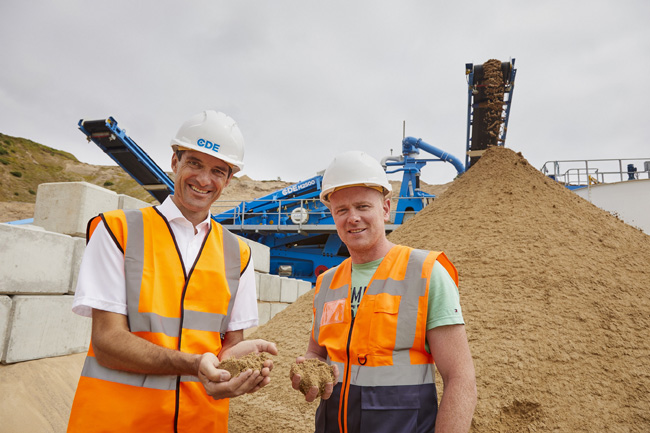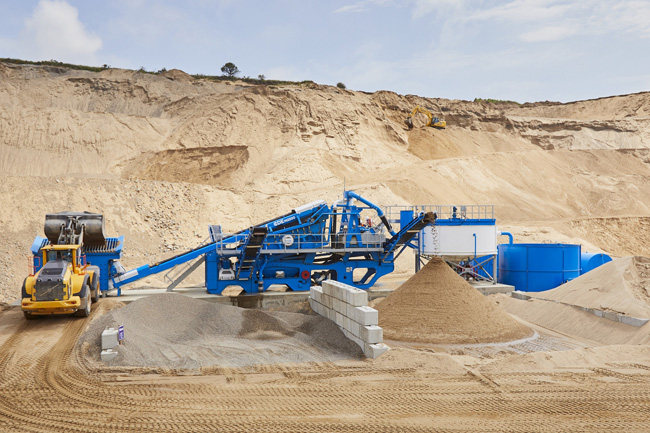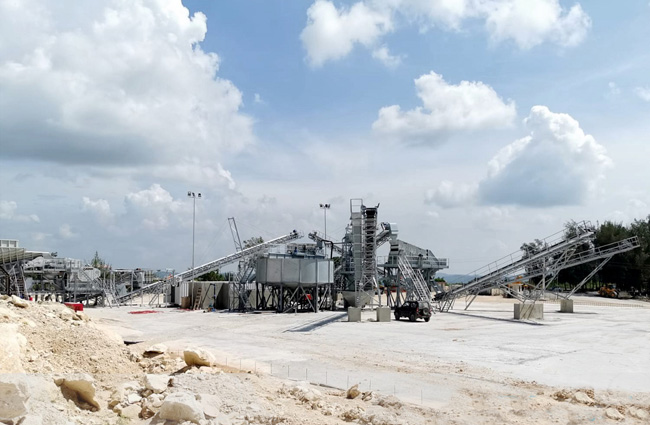
Terex Washing Systems has hosted the global premiere of the AggWash 300 modular wash plant in conjunction with its UK distributor Duo and their customer NRS Group at NRS Woodcote Wood Quarry near Shifnal in Shropshire, England.
Event attendees enjoyed tours around and demonstrations of the AggWash 300 along with Terex AquaClear, Terex’s first water management treatment system, said to meet the growing need for water management due to new environmental legislation being introduced globally. Duo also highlighted all its business divisions, including equipment sales, contract processing, operations, manufacturing, international sales, parts, servicing and pre-used equipment for a variety of industries including quarrying, aggregates, recycling, materials handling, logistics, and construction.
Capable of producing up to 300 tonnes per hour of material and a big brother model to TWS’s popular AggWash 60 and AggreScrub 150 modular wash plant, the AggWash 300 has a space-saving modular design allowing for a high output on a reduced footprint. This makes it a rapid install solution for a diverse range of applications with the aggregates, recycling, remediation and mining sector. Designed with an uncompromising approach towards reliability and durability, the AggWash 300 can produce four grades of aggregates and two grades of sand.
Terex AquaClear includes clarifying tanks, flocculent dosing systems, filter presses and all associated equipment. Importantly, the system enables Terex Washing Systems to offer an end-to-end solution for washing and water management.
The AggWash 300 was launched in June 2018 at the
Speaking to Aggregates Business during the AggWash 300 global premiere event on 2-3 July 2019, Mark Ketcher, NRS Group founder and managing director, said: “I saw the AggWash 300 at Hillhead and thought ‘that’s exactly what I want’, and the model at the show got delivered straight to us. We’ve had it running [at NRS Woodcote Wood Quarry] for around 20 weeks. It’s had a few teething problems, but we’ve had great support from Duo and Terex Washing Systems. We are also having the [AquaClear] filter press installed in the next six to eight weeks. We may put our 200 [tonnes per hour] sand plant in and modify the 120 [tonnes/hour] one we’ve got.
“We are producing around 250 tonnes an hour from the AggWash 300, but the plant can produce up to 350 tonnes per hour. We’ve got three other plant from Terex – a triple-deck 200 tonnes an hour, a 16 x 5 double-deck processing C&D [construction and demolition] waste, and we’ve just installed a triple-deck 200 Log Washer plant with two crushers on it at a former Tarmac site in Meriden. It’s got fully galvanised steel and is a nice setup. All our sites make ultra-fines, three grades of sand and three grades of gravel – -10mm, 10-20mm and 20-40mm. All the sites have Terex cone and impact crushers.
“Terex and Duo offer good service. I like the guys and they all know me. We’ve spent in excess of £10 million alone on Terex Washing Systems’ wash plants in recent years.”
A business employing over 100 people, Ketcher says NRS Group may have a fifth potential quarry in which to deploy its AggWash 300, with a planning application in for a site in Kidderminster.
Commenting on current UK C&D waste and virgin aggregates demand, Ketcher said: “We’re busy. Everything we make, we sell. We are going into new avenues all the time. For instance, we are looking at more waste treatment facilities and incinerator bottom ash production. Really, we’re interested in any waste streams that we can turn into aggregates. When you can make a concrete product, especially, out of recycled aggregates, it’s fantastic. It’s a win-win. You get a gate fee and you are making a product you can sell or use in your own civils work.

At its site near the village of Blackwater, in Wexford, southeast Ireland, D’Arcy Sands was facing a combination of site-specific challenges, namely water supply and reliance on a traditional bucket wheel classifying system. It partnered with industry-leading wet processing equipment manufacturer
With operations in counties Wexford and Wicklow, D’Arcy Sands, owned by father and son business duo Anthony and Tony D’Arcy, has been producing high-quality building materials and sports sands for over 25 years.
The firm specialises in the production of quality graded sands for a range of sports, including outdoor, synthetic and all-weather sports pitches; sands for golf courses, including bunkers and top dressing for greens and fairways; and its silica sands are also used widely in equestrian sports for training surfaces and racetracks.
Over the years, D’Arcy Sands has worked with clients throughout the UK and Ireland, supplying sands for major projects and events including the Dubai Duty Free Irish Open, Croke Park, Thomond Park, Curragh Racecourse, and Adare Manor Hotel Resort.
Recently, the company secured a contract to supply its sands to the Aviva Stadium in Dublin.
D’Arcy Sands produces high-spec sports sands for some of the most prestigious venues and events in the UK and Ireland. It’s therefore important that the quality and prestige of these projects is reflected in the standard of its product.
Until its new CDE plant was commissioned, D’Arcy Sands had been using a tracked rinser and traditional bucket wheel system for sand classification and dewatering.
An upgrade of the existing bucket wheel system was required to tackle the loss of valuable materials to ponds and excess moisture in the final products.
Water availability proved to be another significant challenge at the company’s Wexford site. So much so that it was transporting its sports sand more than nine miles to a separate site with sufficient water supply.

As well as water management, Tony D’Arcy, manager at D’Arcy Sands, said energy efficiency was another important consideration.
“The plant we had been operating was powered by a diesel hydraulic system, so there existed the potential for spillages that could contaminate our much sought-after sports sands. We work with world-class venues and arenas, so we wanted to take preventative measures and put in place a system that would remove the risk of product being rejected or returned.”
Garry Stewart, area business development manager at CDE, explained how the new plant was developed using CDE’s co-creation approach.
“Our engineers worked closely with Tony and the team at D’Arcy Sands throughout the design and commissioning process to better understand what the company wanted to achieve by upgrading its plant and to outline any key site challenges they were facing.
“Completed over several site visits and through a series of collaborative design workshops, we designed a bespoke plant specific to D’Arcy Sands to support the company to scale its operations and extract maximum value from the material being processed.”
D’Arcy said: “We wanted to partner with a company that could help us realise our growth ambitions by designing a solution that supported our objectives in the most sustainable and economic way possible. Plant build quality coupled the technical know-how and the expertise of its engineers proved CDE was the ideal fit to deliver on our aims.”
After careful consideration of the site and customer’s requirements, CDE presented a custom-built plant featuring the electric-powered M2500 E4 washing plant with integrated hopper, feed conveyor and twin-deck Infinity P2-75 screen. The plant also includes an integrated water management system comprising the A200 AquaCycle thickener, FlocStation poly dosing plant and AquaStore water tank.
CDE’s M2500 fully integrated modular washing plant combines feeding, screening, sand washing and stockpiling into one compact and mobile chassis. The E4 model would allow D’Arcy Sands to produce up to four commercial-grade washed sand and aggregate products simultaneously.
Importantly for D’Arcy Sands, the M2500 is a maintenance-free and energy-efficient all-electric drive operation. Unlike its former diesel hydraulic system, this eliminates the possibility of product becoming contaminated by spillages.
To improve the efficiency of the company’s day-to-day operations, the new plant incorporates CDE’s cutting-edge water management system, the AquaCycle thickener.
Waste water from the plant is processed by the AquaCycle thickener which recovers up to 90% of the process water to be recirculated back into the washing plant. This ensures moisture content of D’Arcy Sands’ product is reduced from over 20% per cent to an average of 10-15%, resulting in a much faster return on investment (ROI). It also means that, for the first time, the company can process material at its draw site.
The entire system requires under 20m³ of water per hour to operate, an 80% reduction from the 200m³ of water required for its former plant.
Stewart said: “By introducing the CDE AquaCycle, D’Arcy Sands is now able to wash material at its Blackwater site. It’s the custom-built solution designed by CDE that has made this possible for Tony and his team. This was unachievable with the old plant.”
“We’ve doubled production, as a result of the new CDE wet processing plant”, D’Arcy emphasised.
Raw feed material, primarily Wexford sports sand with a small portion of gravel, is being fed into the new plant at a rate of up to 80 tonnes per hour.
“Output is up by over 100%,” he said. “We’re now processing up to 80 tonnes per hour of feed and extracting over 40 tonnes of our quality graded sports sands. Greater control of fines separation using cyclone technology, which is a new development for our operation, has added more value to our products and is driving significant demand.
“The feedback we have been getting from our customers and in particular the greens keepers who use our sand daily has been excellent with numerous positive comments on the quality, percolation and workability of the sand.
“Importantly for us, the new system allows us to wash material at our Blackwater site when previously we had to transport it off-site, almost ten miles, to a location with a better water supply.”
AquaCycle technology is supporting D’Arcy Sands to recycle 90% of their process water requiring a small 20m³ per hour top-up supply which is drawn from a bore well on site.
Inefficiencies in its traditional bucket wheel systems resulted in D’Arcy Sands losing high-value resources to pond, as D’Arcy explains.
“Our new system is recovering this resource and helping us to maintain high product output for our premium sands.”
More effective screening made possible by the M2500, which screens and washes up to four in-spec sand and aggregate products in one process, is opening up new markets and opportunities for D’Arcy Sands.
D’Arcy continued: “Producing commercial grade sports sands has always been the primary focus for D’Arcy Sands, but the new plant is producing new revenue streams for us through the production of higher quality aggregates and opening up new markets.”
Confident in the quality of its commercial grade sports sands and aggregates, and coupled with its growing demand as a result, the company has also purchased adjoining land at its Blackwater site to increase the lifespan of the operation. Stewart added: “D’Arcy Sands is a company ready for the future. It has put in place a solid foundation following the purchase of additional land to extend the life of their Blackwater site. This ensures the company has a good source of material to process with the best possible equipment and access to the right knowledge to achieve their growth ambitions.”

An American quarrying company has partnered with Italian company
The 100 tonnes per hour capacity Baioni washing, crushing and screening plant duo is currently being tested in two different sand and gravel quarries in Central America. Baioni took care of the plant’s assembly and is supervising their testing programme.
The installation of the Baioni plant fulfils the American quarrying firm’s urgent need to produce quality aggregates for use in concrete production, with the final concrete material destined for an array of Central America-based infrastructure and construction works.
Baioni had met representatives of the American quarrying company during a workshop at a Central American trade fair. The client knew of Baioni and had visited a neighbouring company’s working Baioni washing, crushing and screening plant some time ago in order to understand their functionality and structural quality. After several months of close collaboration on plant design, Baoni and the American quarrying company signed a contract to install identical plant on each of the Central American firm’s two sand and gravel quarries.
At the two sites, 650mm feed material is put through two crushing stages, then washed and finally screened out into four fractions: 0-5nn, 5-10mm, 10-20 mm.
In the primary crushing phase, a unit consisting of a BP 110/70 jaw crusher, an apron feeder and a GD 90/8 wobbler feeder capable of effectively pre-selecting and cleaning the coarse material, has been preferred. In the secondary crushing phase, a MIL 1000SP reversible hammer mill with fixed hammers is used, due to its high reliability when matched with the material to be processed. The material passes through an accurate washing process to remove all impurities. To facilitate this, a washing and recovery station has been created to separate the silt and recover sands with characteristics of various granulometry. The washing and sand recovery station comprises a GRF hydrocyclone, a tank and a dewatering screen.
Cyclone technology involves the use of centrifugal force to classify materials rather than gravity. The aim of the sand recovery group with hydrocyclone is to treat sand mixed with water (slurry) and to return dry sand. Slimes release the overflow in the upper part of the cyclone with waste water, to be then sent to a water management system. The fraction of sand leaves the lower part of the cyclone, is drained and made ready for storage.
This way, product yield is maximised and operating costs reduced. Water treatment plant are becoming increasingly vital equipment in quarries as their benefits outweigh the initial investment. The return on investment on a Baioni BaiWash system is, says Baioni, usually six to nine months. The innovative washing system improves productivity by bringing together one-of-a-kind washing technology with on-site training and service after the installation, ensuring an operation’s entire crew can quickly and capably achieve the best results from the washing solution.
Duncan High, division manager – processing equipment technology, of Haver & Boecker Niagara’s Canadian facility, has spoken of how best to maximise natural resources, such as water, in quarries and mines.
“Water use restrictions and permitting challenges continue to increase, making it harder for operations to find ways to stay profitable while using fewer resources. As a result, aggregates and mining operations are moving toward new technology to conserve natural resources while increasing long-term savings and ROI.

“One way the industry has adapted to conserve water is through the use of settling ponds. Advanced washing systems, when paired with a settling pond, can reduce water consumption by as much as 75% over traditional washing systems. That allows operations to cut their water use and limit their water treatment requirements and necessary equipment. It also makes an advanced washing system more favourable as governments push aggregate producers to use new technology to meet new restrictions.”
High notes how some new washing systems can pump water at very high pressures — as high as 2,000 psi — through spray nozzles at 211gpm in a matter of seconds. He adds: “That’s a huge benefit to operations running under strict restrictions. The equipment’s high-pressure jets effectively remove fines and dirt from deep crevices, such as marine limestone or porous rock. The advanced washing systems can be used to wash prescreened materials which have small fines sticking to the larger particles. This is accomplished by washing the material initially and conducting a final rinse over a vibrating screen.”
High explains that producers can save as much as 15% in energy costs by switching to new washing systems. Part of this is due to the speed at which the new washers complete a cycle. On average, alternative washing methods, such as log washers, retain materials for three minutes or more while materials stay in a high-pressure washing drum for just seconds.
“Best of all, advanced washing systems can restore value from what might have previously been deemed waste — reducing waste streams and breathing new life into vital resources, while putting more money in the producer’s pocket.
“Advanced washing systems can do a lot to reduce an operation’s environmental footprint, as well as help improve profits. Work with a manufacturer to determine the best fit for each site and its unique characteristics,” concludes High.












